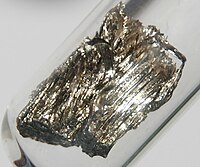
Photo from wikipedia
The effect of magnesium impurity on luminescent properties of alumina ceramics sintered at high temperatures under vacuum is studied by pulsed cathodoluminescence, photoluminescence, and thermoluminescence. At dopant concentrations >1 wt… Click to show full abstract
The effect of magnesium impurity on luminescent properties of alumina ceramics sintered at high temperatures under vacuum is studied by pulsed cathodoluminescence, photoluminescence, and thermoluminescence. At dopant concentrations >1 wt %, high-temperature synthesis results in formation of defects associated with magnesium, which were identified in the pulsed cathodoluminescence (520 nm) and photoluminescence (767 nm) spectra, as well as in the thermoluminescence curves (380 K). It is found that increased magnesium concentration leads to luminescence quenching of the intrinsic centers (F centers) of alumina in the PCL emission band at 400 nm, impurity defects (Mn4+ and Cr3+) in the photoluminescence emission bands at 673 and 689 nm, and all the recorded thermoluminescence peaks at 380, 450, and 615 K.
Journal Title: Physics of the Solid State
Year Published: 2019
Link to full text (if available)
Share on Social Media: Sign Up to like & get
recommendations!